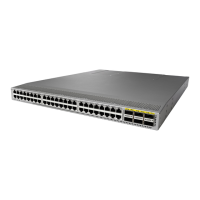Send document comments to nexus3k-docfeedback@cisco.com
9-5
Cisco Nexus 3000 Series NX-OS Unicast Routing Configuration Guide, NX-OS Release5.0(3)U1(1)
Chapter 9 Configuring Layer 3 Virtualization
Licensing Requirements for VRFs
Licensing Requirements for VRFs
The following table shows the licensing requirements for this feature:
Guidelines and Limitations
VRFs have the following configuration guidelines and limitations:
• When you make an interface a member of an existing VRF, Cisco NX-OS removes all Layer 3
configuration. You should configure all Layer 3 parameters after adding an interface to a VRF.
• You should add the mgmt0 interface to the management VRF and configure the mgmt0 IP address
and other parameters after you add it to the management VRF.
• If you configure an interface for a VRF before the VRF exists, the interface is operationally down
until you create the VRF.
• Cisco NX-OS creates the default and management VRFs by default. You should make the mgmt0
interface a member of the management VRF.
• The write erase boot command does not remove the management VRF configuration. You must use
the write erase command and then the write erase boot command.
VRF-lite has the following guidelines and limitations:
• A switch with VRF-lite has a separate IP routing table for each VRF, which is separate from the
global routing table.
• Because VRF-lite uses different VRF tables, the same IP addresses can be reused. Overlapped IP
addresses are allowed in different VPNs.
• VRF-lite does not support all MPLS-VRF functionality; it does not support label exchange, LDP
adjacency, or labeled packets.
• Multiple virtual Layer 3 interfaces can be connected to a VRF-lite switch.
• The switch supports configuring a VRF by using physical ports, VLAN SVIs, or a combination of
both. The SVIs can be connected through an access port or a trunk port.
• The Layer 3 TCAM resource is shared between all VRFs. To ensure that any one VRF has sufficient
CAM space, use the maximum routes command.
• A switch using VRF can support one global network and up to 64 VRFs. The total number of routes
supported is limited by the size of the TCAM.
• VRF-lite supports BGP, RIP, and static routing.
• VRF-lite does not support EIGRP.
• VRF-lite does not affect the packet switching rate.
• Multicast cannot be configured on the same Layer 3 interface at the same time.
• VRF-lite is supported only on an IPv4 network.
Product License Requirement
Cisco NX-OS VRFs require no license. Any feature not included in a license package is bundled with the Cisco NX-OS
system images and is provided at no extra charge to you. For a complete explanation of the Cisco NX-OS
licensing scheme, see the Cisco NX-OS Licensing Guide.

